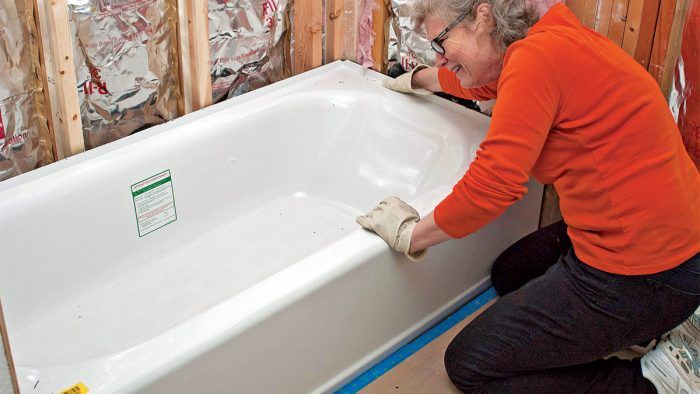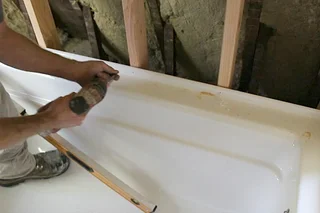Just about every person will have their own unique notions involving How to Install a Bathtub Yourself.

Setting up a bathtub isn't exactly brain surgery, yet it does need solid plumbing, carpentry, and also often, tiling skills. Replacing an old bath tub with a brand-new one is also a reasonably tough project. If the old bathtub is easily available, the task can move quickly; if you need to open a wall to remove the old tub and also place the new bath tub, the job is much harder. In either situation, the task is within a residence handyman's skills, although you will need an assistant to leave the old tub and embeded in the new one. Make certain you have qualified on your own for the task and also are comfortable attempting it. Instead of working with a professional to take control of a halfway-completed task, it is far better to take into consideration employing one prior to you begin. Possibilities are you might need a specialist plumber to make tube connections.
This post will certainly help you set up a brand-new bathtub in your shower room if you have actually already purchased a brand-new bathtub and don't need to alter the setup of your previous water supply pipes.
Your tools as well as product list need to consist of the following:
Removing Old Touches
If you require to change old faucets with new ones as a part of your installation, then the first thing you should do is separate the water. After doing so, activate the faucets to drain any water continuing to be in the system. The process of removing the existing taps can be quite bothersome as a result of the restricted accessibility that is typically the situation.
Utilize a basin wrench (crowsfoot spanner) or a tap device to reverse the nut that links the supply pipes to the faucets. Have a towel prepared for the remaining water that will originate from the pipes. Once the supply pipelines have been removed, make use of the exact same device to loosen up the nut that holds the taps onto the bath/basin. You will require to stop the single faucets from turning during this procedure. Once the faucets have actually been removed, the holes in the bath/basin will certainly have to be cleansed of any type of old securing compound.
Before proceeding to fit the brand-new faucets, contrast the pipeline links on the old faucets to the new taps. If the old taps are longer than the new taps, then a shank adapter is required for the new taps to fit.
Fitting New Touches
If the tails of the brand-new faucets are plastic, after that you will certainly require a plastic port to avoid damage to the thread. One end of the connector fits on the plastic tail of the tap and also the various other end supplies a link to the current supply pipes.
If you require to fit a monobloc, then you will need reducing couplers, which connects the 10mm pipe of the monobloc to the typical 15mm supply pipeline.
Next off, place the tap in the mounting opening in the bath/basin making certain that the washing machines are in place in between the faucet and the sink. Safeguard the faucet in place with the supplier supplied backnut. Once the faucet is securely in position, the supply pipes can be attached to the tails of the taps. The faucets can either be linked by using corrugated copper piping or with normal faucet connectors. The previous kind ought to be attached to the tap ends initially, tightening just by hand. The supply pipes can later on be connected to the various other end. Tighten both ends with a spanner after both ends have actually been connected.
Setting up the Tub
Making use of both wood boards under its feet, place the bathtub in the required setting. The wooden boards are practical in equally spreading out the weight of the bath tub over the location of the boards as opposed to concentrating all the weight onto 4 little factors.
The next goal is to guarantee that the bathtub is leveled all round. This can be achieved by checking the level and also changing the feet on the tub until the level reads degree.
To mount faucets, fit the bottom of the outermost flexible tap connector to the ideal supply pipeline by making a compression join; then do the exact same for the other faucet.
Switch on the water system and examine all joints and also brand-new pipework for leaks and also tighten them if necessary. Fill the bath tub and also inspect the overflow outlet and the regular outlet for leaks.
Ultimately, repair the bath paneling as explained in the producer's user's manual. Tiling as well as securing around the tub should wait up until the bathtub has been used at the very least when as this will resolve it into its last position.
Getting ready for the Installation
Firstly, the sustaining structure provided with the bath ought to be fitted (if required) according to the manufacturer's instructions. Next off, fit the faucets or mixer to the bath tub. When suitable the tap block, it is essential to ensure that if the tap comes with a plastic washer, it is fitted between the bathroom and also the taps. On a plastic bathroom, it is also sensible to fit a supporting plate under the taps device to prevent stress on the tub.
Fit the flexible tap connectors to the bottom of both taps making use of 2 nuts and also olives (often supplied with the tub). Fit the plug-hole electrical outlet by smearing mastic filler round the sink outlet opening, and then pass the outlet via the hole in the bath. Utilize the nut provided by the manufacturer to fit the plug-hole. Take a look at the plug-hole electrical outlet for an inlet on the side for the overflow pipe.
Next, fit the end of the flexible overflow pipeline to the overflow electrical outlet. After that, screw the pipe to the overflow face which need to be fitted inside the bath. Make certain you use all of the provided washing machines.
Link the catch to the bottom of the waste electrical outlet on the bathtub by winding the thread of the waste outlet with silicone mastic or PTFE tape, as well as screw on the catch to the electrical outlet. Connect the bottom of the overflow tube in a similar manner.The bath ought to now be ready to be fitted in its final position.
Tiling Around the Bathtub
In the location where the bathroom fulfills the ceramic tile, it is required to seal the joins with a silicone rubber caulking. This is very important as the installation can move sufficient to break a rigid seal, creating the water to penetrate the wall in between the bath and also the tiling, causing complications with moisture as well as feasible leakages to the ceiling listed below.
You can select from a range of coloured sealers to assimilate your components and also fittings. They are marketed in tubes as well as cartridges, and also are capable of securing spaces as much as a width of 3mm (1/8 inch). If you have a bigger gap to load, you can fill it with spins of drenched paper or soft rope. Bear in mind to constantly load the tub with water before securing, to allow for the motion experienced when the bathtub is in use. The sealer can crack relatively very early if you do not take into account this motion prior to securing.
Conversely, ceramic coving or quadrant tiles can be used to edge the bath or shower tray. Plastic strips of coving, which are easy to use as well as cut to dimension, are likewise conveniently available on the marketplace. It is recommended to fit the floor tiles utilizing waterproof or waterproof sticky and also cement.
Bathtub Installation
How Important Is A Bathtub To Your Home?
High-quality baths, showers, and other bathroom updates are necessary when considering a smart investment in your home. It’s a room that you go to every day and one that is constantly being used by guests.The bathroom is one of the top trafficked rooms in a home and also one of the most valuable in terms of home resale.
Install Piping Before Tub
You will be using your existing drain and waste vent system, but pipes required include the hot and cold water supply lines and a pipe leading to a shower head. A mixing valve and shower head are also needed. Air chambers may be required.
Position the Tub
Lower the tub into place so that the continuous flange fits against the wall studs and rests on 1’x4' or 2’x4' supports. Anchor the tub to the enclosure with nails or screws inserted through the flanges into the studs.
NOTE: Remember, bathtubs and shower stalls may require support framing. A bathtub filled with water is extremely heavy, so check building codes and framing support before installing the tub.
Assemble Drain Connections
Assemble the bathtub drain connections by connecting the tub overflow with the tub drain above the trap, not beyond it. The trap will have a compression fitting that screws over the arm of the overflow assembly.
Place a Pipe For the Shower Head
First, locate a brass female threaded winged fitting and attach it to a framing support via a screw or a nail. Then run a pipe up the wall for the shower head. Sweat or solder the other side of the brass fitting to the top of the pipe.
Attaching Hot and Cold Water Lines
Attach your water lines for both hot and cold by sweating these directly into the hot and cold ports of the mixing valve. The mixing valve will be how water enters the tub’s system, not by the pipes themselves.
Install the Spout
Extend a piece of 1/2 inch pipe, or whichever length is specified in the manufacturer’s instructions, for the tub spout. Sweat on a male threaded fitting at the end of the pipe or use a brass nipple of the proper length and a 1/2 inch cap.
NOTE: At this point you should have your rough-in plumbing work inspected before proceeding further.
Check For Leaks
Restore the water pressure and check the drain connection and the supply pipes for any sign of leaking.
estore the Bathroom Wall
Replace the wall with moisture-resistant drywall as a base for your wall covering. Seal the joints between the wall and your new tub with silicone caulk as protection against water seepage.
https://www.berkeys.com/2016/12/02/bathtub-installation-dallas/

We hope you enjoyed our post on How to Install a Bathtub Yourself. Many thanks for taking a few minutes to read through our piece of content. Sharing is good. Who knows, you could be doing someone a favor. We treasure reading our article about A Step-by-Step Guide to Installing a Bathtub.
Got a leak? Call!